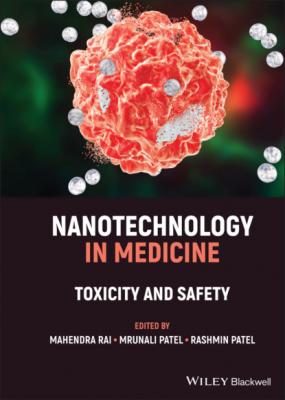Nanotechnology in Medicine. Группа авторов
Чтение книги онлайн.
Читать онлайн книгу Nanotechnology in Medicine - Группа авторов страница 27
 et al. 2014).
et al. 2014).
Figure 2.4 Main pathways of the metabolism of benzene and its derivatives in humans. *MPO, Myeloperoxidase; **NQO1, Quinone oxidoreductase 1 NADPH dependent.
Sources: Based on Chaney and Carlson (1995), Ross (1996), Monks et al. (2010) and Moro et al. (2013).
The biotransformation reactions of benzene (via muconic acid and phenol) are explained by the need for obtaining water‐soluble compounds for urinary excretion. Human exposure to benzene, in concentrations between 0.1 and 10 ppm, results in urinary metabolite profiles with 70–85% phenol, 5–10% hydroquinone, 5–10% trans, trans‐muconic acid and catechol, and less than 1% S‐phenylmercapturic acid (Qu et al. 2002; Kim et al. 2006; Barata‐Silva et al. 2014). This is a clear indication of the toxicity of oxygenated compounds derived from benzene.
As for the microbial metabolism of benzene and its derivatives, the anaerobic pathway is a slow process and its biochemical mechanism has not been fully described (Coates et al. 1996). In general, the metabolic pathways of hydrocarbon degradation involve an aerobic metabolism carried out by bacteria, lignin‐degrading fungi (lignolytics), and non‐lignolytic fungi (Jacques et al. 2007).
In some fungi, the metabolism of benzene and its derivatives occurs in a similar way as humans, using the same metabolic reactions (via muconic acid and phenol) (Figure 2.5). However, the phenolic compounds originated here are conjugated with O‐glycosides and O‐glucoronides (Cerniglia 1984). The reactions occurring in any of these phases can be considered as detoxification measures if the products generated are less toxic than the original hydrocarbons (Cerniglia et al. 1985).
Lignolytic fungi have alternative pathways for the degradation of aromatic compounds. This degradation occurs through the action of extracellular enzymes of low specificity, such as lignin peroxidase, manganese peroxidase, and laccase (Leonowicz et al. 1999). In this process, benzene and its derivatives are degraded, with the formation of quinones (Cerniglia 1997). Some lignolytic fungi have the ability to metabolize quinone PAHs by cleaving aromatic rings with subsequent breaking and formation of carbon dioxide (through the Krebs cycle reactions) (Hammel 1995) (Figure 2.5).
Figure 2.5 Aerobic biodegradation pathways of aromatic compounds conducted by bacteria and fungi.
Source: Based on Cerniglia (1984, 1997). *, Products resulting from reactions of the Krebs cycle.
Understanding the microbial degradation of benzenes and other aromatic compounds present in synthetic polymers is very important considering that these materials will be disposed, and biodegradation can generate compounds that are even more toxic or that may impact other living organisms of the environment.
The metabolism of biopolymers such as exopolysaccharides (EPSs) and polyesters does not generate toxic and reactive compounds, as is the case of aromatic/synthetic polymers. The metabolization of an EPS or microbial polyesters leads to the formation of organic acids, most often found in the Krebs cycle (Eggers and Steinbuchel 2013). Both humans and capable microorganisms can degrade biopolymers by well‐known metabolic pathways, such as glycolysis, respiratory chain, Lynen cycle (β‐oxidation of fatty acids), among others. The metabolism of biopolymers is generally complete, leading to carbon dioxide and water, but if it is not, it generates compounds of low environmental toxicity.
2.5 Conclusions
The exploitation of microbial polymers for the design of novel therapeutic systems has evolved radically during the last decades, as they correspond to tunable, nontoxic, biodegradable, and biocompatible materials. Processing such materials in the form of nanofibers and nanoparticles is a very promising strategy that may provide more effective and convenient routes of administration, leading to sophisticated macromolecular materials for pharmaceutical and biomedical purposes. The applications of nanomaterials based on microbial polymers in biomedicine have become a large subject area, with original materials continuously being described in literature. As a consequence, commercial biomedical nanosystems based on exopolysaccharides (mainly pullulan and bacterial cellulose) and polyhydroxyalkanoates (mainly poly[hydroxybutyrate]), are expected to appear more frequently, as they may offer excellent prospects.
References
1 Adhikari, H.S. and Yadav, P.N. (2018). Anticancer activity of chitosan, chitosan derivatives, and their mechanism of action. International Journal of Biomaterials 2018: 2952085. PMID: 30693034. https://doi.org/10.1155/2018/2952085.
2 Alhariri, M., Azghani, A., and Omri, A. (2013). Liposomal antibiotics for the treatment of infectious diseases. Expert Opinion on Drug Delivery 10: 1515–1532. https://doi.org/10.1517/17425247.2013.822860.
3 Alle, M., Reddy, G.B., Kim, T.H. et al. (2019). Doxorubicin‐carboxymethyl xanthan gum capped gold nanoparticles: microwave synthesis, characterization, and anti‐cancer activity. Carbohydrate Polymers 115511 https://doi.org/10.1016/j.carbpol.2019.115511.
4 Andrady, A.L. and Neal, M.A. (2009). Applications and societal benefits of plastics. Philosophical Transactions of the Royal Society B: Biological Sciences 364: 1977–1984.
5 Bakhsheshi‐Rad, H.R., Hadisi, Z., Ismail, A.F. et al. (2019). In vitro and in vivo evaluation of chitosan‐alginate/gentamicin wound dressing nanofibrous with high antibacterial performance. Polymer Testing 106298 https://doi.org/10.1016/j.polymertesting.2019.106298.
6 Barata‐Silva, C., Mitri, S., Pavesi, T. et al. (2014). Benzeno: reflexos sobre a saúde pública, presença ambiental e indicadores biológicos utilizados para a determinação da exposição. Cadernos Saúde Coletiva 22: 329–342. https://doi.org/10.1590/1414‐462X201400040006.
7 Belgacem, M.N. and Gandini, A. (2008). Monomers, Polymers and Composites from Renewable Resources. Elsevier.
8 Belsky, I., Gutnick, D., L., and Rosenberg, E. (1979). Emulsifier of Arthrobacter RAG‐1: determination of emulsifier‐bound fatty acids. FEBS Letters 101: 175–178.
9 Bomfim, M.V.J., Abrantes, S.M.P., and Zamith, H.P.S. (2009). Estudos sobre a toxicologia da ε‐caprolactama. Brazilian Journal of Pharmaceutical Sciences 45 (1): 21–35. https://doi.org/10.1590/S1984‐82502009000100004.
10 Borges, C. and Vendruscolo, C. (2008). Xanthan gum: characteristics and operational conditions of production. Semina: Ciências Biológicas e da Saúde 29: 171–188. ISSN: 1676‐5435.
11 Campos‐Takaki, G.M., Dietrich, S.M.C., and Beakes, G.W. (2014). Cytochemistry, ultrastructure and X‐ray microanalysis methods applied to cell wall characterization